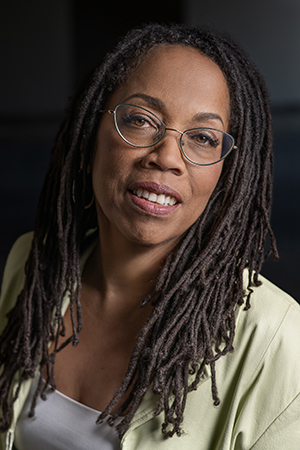Between Words: Siavash Saadlou interviews Gloria Blizzard

Past CNF Prize winner Siavash Saadlou talks with Gloria Blizzard, judge for our 2024 Creative Nonfiction Prize contest. They discuss overlapping truths, production as the other side of craft, and how absence can play a role in the telling of traumatic events.
Gloria Blizzard, a Black Canadian woman of multiple heritages, is an award-winning writer and poet. Her work has received The Malahat Review's Open Season Creative Nonfiction Award, has been nominated for the Queen Mary Wasafiri Life Writing prize, and the Pushcart prize. Additional essays, poetry, and reviews have been published in World Literature Today, Wasafiri International Contemporary Writing, The Humber Literary Review, Musicworks, cbc.ca, byblacks.com, and other publications. Her work was also listed amongst top music writing in 2022 by Invisible Press. Gloria holds a Master of Fine Arts in creative nonfiction from the University of King’s College. Her book of essays Black Cake, Turtle Soup, and Other Dilemmas is published by Dundurn Press.
I’ve noticed music happens to be an inherent part of your identity as an artist. Does that sometimes inform your writing and vice versa?
Even though I rarely play music anymore, my writing has a musical voice within it. Just as there is a rest in a musical stanza, a silence between the notes, the space between words is important to me. A word may be repeated two or three times over the course of a tale and it is deliberate, like repetition of a musical motif. Sometimes, when you place words next to each other, new or deeper meanings are created, like the unfolding of the multiple harmonics around a tone. I might also impose a musical form on a piece as an experiment and see what happens. “The Year of Jazz,” for example, was initially an experiment using the structure of a jazz standard. On the other hand, sometimes the content determines how the story is told.
E. L. Doctorow once famously said that “there is no longer such thing as fiction or nonfiction; there’s only narrative.” What role does narrative play in how you approach your writing?
I often use braided narrative, as there are often so many overlapping and intersecting truths. Laying them over each other, and weaving them together can create new resonance or lead to unexpected conclusions. This allows complexities to exist simultaneously and allow tales or timelines to co-exist. My essay “Passage,” for example, moves from the 1800s to the 1600s and into the present. The importance is that the narrative is propelled forward. There is an impulse and a story that needs to be expressed. Sometimes the search for “truths” is the driving force that pulls the essence of the story out. And the narrative can be linear, braided or something else entirely.
In my experience as a nonfiction writer, especially when revisiting traumatic events, I occasionally find it difficult to “cast a cold eye” on everything so to speak. I wonder if you also have ever had a hard time being dispassionate in how you perceive and then write a personal essay?
I had an editor ask me, “What are you not saying?” Sometimes the pause or absence is deliberate, because something is too hard look at. That absence itself plays a role in the telling. Traumatic events need not always be addressed immediately or directly. Sometimes it is good to look at challenging events out of the corner of your eye, or to wait. It took decades for me to address complex personalities and political scenarios referenced in “Ghost.” In addition, traumatic events or great joys can be expressed in different forms—poetry for example, or the wordless vocabularies of dance. There are many scenarios however, regardless of genre that I still do not touch.
I know that your book of essays, Black Cake, Turtle Soup, and Other Dilemmas, is out now. What was the most challenging part of writing or finalizing it?
The fun part is the writing and editing—the creation of the thing. The challenging part for me comes after that. Maybe we don’t speak about this enough. On the other side of craft is production and dissemination of our works. What it takes to share our work widely can often be an abrupt surprise for authors. That being said, stepping out of the usual ways of being is also a creative act, an extension of self that is both challenging and rewarding. After years of gathering, inhabiting and crafting stories, and publishing in magazines and journals, my first collection of personal essays is out in the world and being read. A recent phenomenon is that people will find phrases or incidents from the book that resonate with them and will quote my words back to me. I love when others find meaning in my specificities.
I can’t let you go without asking this final question: as this year’s Creative Nonfiction Prize judge, what would be the makings of a winning submission for you?
I so look forward to reading new works. I love being surprised, delighted by beauty in language. I love to experience a beautiful, inspired phrase that rings and references something deeper.
Like many artists, as part of both musical and literary communities, I’ve served on arts council juries. There are always pieces that stand out. It could be a voice, a lens, or a tale with compelling urgency and drive. This is creative nonfiction. Take me to your places. I want to experience your worlds.

Siavash Saadlou









